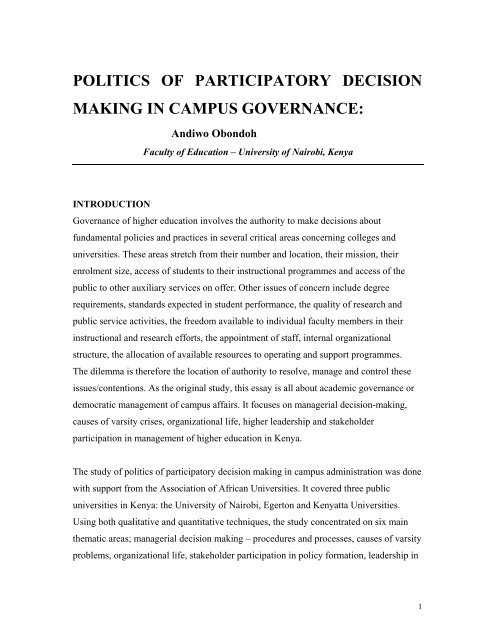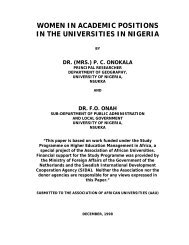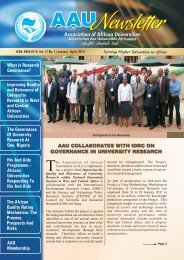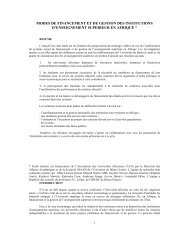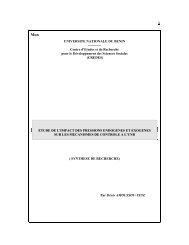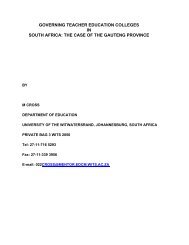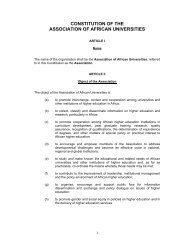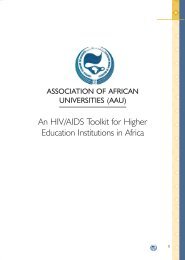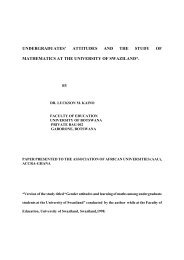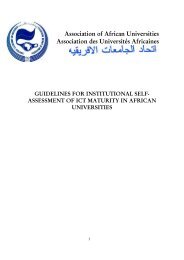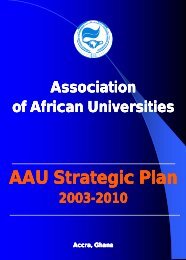politics of participatory decision making in campus governance
politics of participatory decision making in campus governance
politics of participatory decision making in campus governance
- No tags were found...
You also want an ePaper? Increase the reach of your titles
YUMPU automatically turns print PDFs into web optimized ePapers that Google loves.
POLITICS OF PARTICIPATORY DECISION<br />
MAKING IN CAMPUS GOVERNANCE:<br />
Andiwo Obondoh<br />
Faculty <strong>of</strong> Education – University <strong>of</strong> Nairobi, Kenya<br />
INTRODUCTION<br />
Governance <strong>of</strong> higher education <strong>in</strong>volves the authority to make <strong>decision</strong>s about<br />
fundamental policies and practices <strong>in</strong> several critical areas concern<strong>in</strong>g colleges and<br />
universities. These areas stretch from their number and location, their mission, their<br />
enrolment size, access <strong>of</strong> students to their <strong>in</strong>structional programmes and access <strong>of</strong> the<br />
public to other auxiliary services on <strong>of</strong>fer. Other issues <strong>of</strong> concern <strong>in</strong>clude degree<br />
requirements, standards expected <strong>in</strong> student performance, the quality <strong>of</strong> research and<br />
public service activities, the freedom available to <strong>in</strong>dividual faculty members <strong>in</strong> their<br />
<strong>in</strong>structional and research efforts, the appo<strong>in</strong>tment <strong>of</strong> staff, <strong>in</strong>ternal organizational<br />
structure, the allocation <strong>of</strong> available resources to operat<strong>in</strong>g and support programmes.<br />
The dilemma is therefore the location <strong>of</strong> authority to resolve, manage and control these<br />
issues/contentions. As the orig<strong>in</strong>al study, this essay is all about academic <strong>governance</strong> or<br />
democratic management <strong>of</strong> <strong>campus</strong> affairs. It focuses on managerial <strong>decision</strong>-<strong>mak<strong>in</strong>g</strong>,<br />
causes <strong>of</strong> varsity crises, organizational life, higher leadership and stakeholder<br />
participation <strong>in</strong> management <strong>of</strong> higher education <strong>in</strong> Kenya.<br />
The study <strong>of</strong> <strong>politics</strong> <strong>of</strong> <strong>participatory</strong> <strong>decision</strong> <strong>mak<strong>in</strong>g</strong> <strong>in</strong> <strong>campus</strong> adm<strong>in</strong>istration was done<br />
with support from the Association <strong>of</strong> African Universities. It covered three public<br />
universities <strong>in</strong> Kenya: the University <strong>of</strong> Nairobi, Egerton and Kenyatta Universities.<br />
Us<strong>in</strong>g both qualitative and quantitative techniques, the study concentrated on six ma<strong>in</strong><br />
thematic areas; managerial <strong>decision</strong> <strong>mak<strong>in</strong>g</strong> – procedures and processes, causes <strong>of</strong> varsity<br />
problems, organizational life, stakeholder participation <strong>in</strong> policy formation, leadership <strong>in</strong><br />
1
higher education and f<strong>in</strong>ally higher education management <strong>in</strong> the ongo<strong>in</strong>g democratic<br />
transition.<br />
The major focus however, was the nature and extent <strong>of</strong> student and staff <strong>in</strong>volvement <strong>in</strong><br />
<strong>mak<strong>in</strong>g</strong> <strong>decision</strong>s and formulat<strong>in</strong>g policies, which govern higher education <strong>in</strong> Kenya.<br />
Other core areas <strong>in</strong>cluded <strong>in</strong>formation process<strong>in</strong>g, communication and exchange as well<br />
as motivations beh<strong>in</strong>d managerial and academic problems. The remarks that follow are<br />
reflections based on this study.<br />
THE CRISIS OF GOVERNANCE<br />
Accord<strong>in</strong>g to this study, decentralization <strong>of</strong> leadership accountability to faculty and<br />
associated departments or units has proved to be the greatest management challenge to<br />
<strong>campus</strong> adm<strong>in</strong>istration <strong>in</strong> our times. As higher education expands, management <strong>of</strong> our<br />
universities cont<strong>in</strong>ues to be characterized by:<br />
• Apparent mismatch between authority and responsibility <strong>of</strong> primary management units<br />
• Limited authority at lower units<br />
• Entrenched cultures giv<strong>in</strong>g rise to slow <strong>decision</strong> <strong>mak<strong>in</strong>g</strong> processes and sluggish response to change.<br />
• Over reliance on the committee system<br />
• Dim<strong>in</strong>ish<strong>in</strong>g <strong>in</strong>stitutional and group culture, among others.<br />
In <strong>decision</strong>-<strong>mak<strong>in</strong>g</strong> and policy formation, the preferred choices should depend, on the<br />
contrary, on problems, available options, environment/context and persons/groups<br />
<strong>in</strong>volved. The two processes must further take <strong>in</strong>to account <strong>in</strong>gredients <strong>of</strong> <strong>participatory</strong><br />
management {which co<strong>in</strong>cidentally are not very common <strong>in</strong> our university structures} as:<br />
• Mechanisms for consultations<br />
• Consensus build<strong>in</strong>g<br />
• Policy options/alternatives<br />
• Open discussions<br />
• Delegation and spread <strong>of</strong> authority<br />
• Concessions and implementation process.<br />
2
These <strong>in</strong>gredients are not always l<strong>in</strong>ked to factors which, <strong>in</strong>fluence stakeholder<br />
participation <strong>in</strong> college adm<strong>in</strong>istration such as emergent policies <strong>of</strong> government,<br />
management structures, leadership styles and welfare needs. The political <strong>in</strong>terference as<br />
manifested <strong>in</strong> government <strong>in</strong>volvement <strong>in</strong> university affairs was found to be <strong>in</strong>imical to<br />
the development <strong>of</strong> university autonomy and academic freedom, hence compound<strong>in</strong>g the<br />
problem <strong>of</strong> <strong>governance</strong>. This relationship has been commonly used as a pretext for<br />
<strong>in</strong>tervention by the president (head <strong>of</strong> state) and/or his agents <strong>in</strong> university affairs. As a<br />
result <strong>of</strong> the overbear<strong>in</strong>g presence <strong>of</strong> the presidency <strong>in</strong> management <strong>of</strong> universities,<br />
<strong>in</strong>clud<strong>in</strong>g key appo<strong>in</strong>tments, the experience <strong>of</strong> Kenyan public universities is that key<br />
policy matters are very much <strong>in</strong> the hands <strong>of</strong> the government while academics/students<br />
only have a limited say <strong>in</strong> the determ<strong>in</strong>ation <strong>of</strong> academic and social-welfare policies.<br />
Just as Sanyal {1995} 1 identified, part <strong>of</strong> the problems h<strong>in</strong>der<strong>in</strong>g decentralization and<br />
departmental management have to do with centralized bureaucracy, state <strong>in</strong>terest <strong>in</strong><br />
university <strong>governance</strong>, distrust <strong>of</strong> local level participation, lack <strong>of</strong> management know<br />
how and unwill<strong>in</strong>gness to assume management responsibilities by stakeholders. For some<br />
changes to take effect <strong>in</strong> this respect, the adm<strong>in</strong>istrative and academic w<strong>in</strong>gs <strong>of</strong> the<br />
university must work <strong>in</strong> a spirit <strong>of</strong> cooperation. Understand<strong>in</strong>g and human touch must be<br />
present <strong>in</strong> the university <strong>campus</strong>, <strong>in</strong> the classrooms, co-curricular activities, and even<br />
purely adm<strong>in</strong>istrative matters. L<strong>in</strong>es <strong>of</strong> communication between different sections <strong>of</strong> the<br />
university community must always rema<strong>in</strong> alive, open and never allowed to get blocked.<br />
The structure <strong>of</strong> the university will have to avoid complexity <strong>in</strong> the <strong>decision</strong>-<strong>mak<strong>in</strong>g</strong><br />
processes, over centralization, lack <strong>of</strong> active and widespread participation by the<br />
academic staff, students, support team and <strong>in</strong>adequate channels <strong>of</strong> communication. Much<br />
<strong>of</strong> this lie outside the scope <strong>of</strong> legislation about <strong>governance</strong> <strong>of</strong> universities for it depends<br />
on the attitudes and habits <strong>of</strong> the people <strong>in</strong>volved and on the <strong>in</strong>terest groups present at<br />
each <strong>in</strong>stitution. As Kilemi earlier asserted, our study reconfirmed that conflicts (always)<br />
over liv<strong>in</strong>g allowances, terms and conditions <strong>of</strong> service, limited representation <strong>in</strong><br />
university govern<strong>in</strong>g bodies and perception <strong>of</strong> university authority as defender <strong>of</strong> state-<br />
1 Sanyal C.B et al (1995) The Institutional Management <strong>of</strong> Higher Education <strong>in</strong> Western Africa.<br />
3
<strong>in</strong>terests as opposed to the <strong>in</strong>terests <strong>of</strong> the university, compounds the crisis <strong>of</strong> <strong>governance</strong><br />
(Kilemi, 1992) 2<br />
THE PROBLEM OF PARTICIPATION<br />
Facilitation <strong>of</strong> greater <strong>in</strong>volvement <strong>of</strong> stakeholders <strong>in</strong> college affairs came out as a serious<br />
adm<strong>in</strong>istrative and leadership problem. The general absence <strong>of</strong> culture <strong>of</strong> regular dialogue<br />
and jo<strong>in</strong>t forums <strong>in</strong> our universities is manifested <strong>in</strong> ris<strong>in</strong>g cases <strong>of</strong> unrest. University<br />
problems have been on the <strong>in</strong>crease, as mutual communication fails between the<br />
adm<strong>in</strong>istration and students. The recurrent student unrest and staff disenchantment, are<br />
<strong>of</strong>ten reflections <strong>of</strong> demands for their <strong>in</strong>volvement <strong>in</strong> <strong>campus</strong> <strong>governance</strong>. Rejectionist<br />
tendencies <strong>of</strong> students and their negative reactions to policy statements from the<br />
university authorities and/or <strong>decision</strong>s by their own leaders <strong>in</strong>dicate ord<strong>in</strong>ary students are<br />
not adequately <strong>in</strong>volved <strong>in</strong> process<strong>in</strong>g <strong>of</strong> <strong>decision</strong>s. The other ma<strong>in</strong> problem has been that<br />
<strong>of</strong> <strong>in</strong>teraction and engagement between stakeholders. Due to lack <strong>of</strong> proper and<br />
established structures/mechanisms for consultation, the study revealed that, university<br />
authorities are not accessible at all, they only make appearances to consult dur<strong>in</strong>g times<br />
<strong>of</strong> crises. This further compounds the problem <strong>of</strong> <strong>decision</strong> <strong>mak<strong>in</strong>g</strong> as most <strong>decision</strong>s are<br />
<strong>of</strong>ten made under duress <strong>in</strong> crisis situations. As a result these <strong>decision</strong>s end up not be<strong>in</strong>g<br />
well <strong>in</strong>formed because <strong>of</strong> lack <strong>of</strong> adequate/ample time/for consultation and hence the<br />
managers by and large rema<strong>in</strong> reactionary.<br />
In various ways, exist<strong>in</strong>g mechanisms <strong>of</strong> <strong>campus</strong> <strong>governance</strong> contribute to de-stabiliz<strong>in</strong>g<br />
<strong>in</strong>ternal and external tensions and constra<strong>in</strong> university responsiveness to the needs <strong>of</strong><br />
local and stakeholders, as well as society <strong>in</strong> general (Sa<strong>in</strong>t, 1995) 3 . The other important<br />
aspect is participation <strong>in</strong> these structures. Asked to state whether they attended meet<strong>in</strong>gs<br />
where major <strong>decision</strong>s are made 39.05% said that they attended while 60.95% stated that<br />
they did not. The table below gives a breakdown <strong>of</strong> the level <strong>of</strong> participation <strong>in</strong> various<br />
policy organs.<br />
K<strong>in</strong>d <strong>of</strong> meet<strong>in</strong>g attended<br />
2 Kilemi, M (1992) University Governance: Problems and Prospects <strong>in</strong> Anglophone Africa<br />
4
K<strong>in</strong>d <strong>of</strong> Meet<strong>in</strong>gs F %<br />
College Academic Board 6 14.63<br />
College Management Board 3 7.32<br />
Council Meet<strong>in</strong>gs 3 7.32<br />
Faculty Board 19 46.34<br />
Senate Meet<strong>in</strong>gs 5 12.20<br />
Departmental Committees 36 87.81<br />
It should be noted democratization <strong>of</strong> <strong>decision</strong> <strong>mak<strong>in</strong>g</strong> is important not only because<br />
many conflicts emanate from unequal power relationships but also because universities,<br />
as advocates <strong>of</strong> democratic <strong>in</strong>stitutions, need to practice what they preach.<br />
Democratization <strong>of</strong> university <strong>governance</strong> could be strengthened through widen<strong>in</strong>g the<br />
representation <strong>of</strong> students and staff <strong>in</strong> govern<strong>in</strong>g bodies, <strong>in</strong>creas<strong>in</strong>g the voice/role <strong>of</strong><br />
academics and students <strong>in</strong> the selection <strong>of</strong> top varsity <strong>of</strong>ficials and through the<br />
strengthen<strong>in</strong>g <strong>of</strong> staff and student associations.<br />
The implication here is that even student leaders hardly consult with their colleagues<br />
before and after meet<strong>in</strong>gs <strong>of</strong> policy organs. The major problem therefore is that<br />
mechanisms for proper consultation between/among students themselves and between<br />
students on one hand the college authorities on the other, are limited, if not at all nonexistent.<br />
However, as Okello (1998) 4 observes, if students and staff are <strong>in</strong>volved <strong>in</strong><br />
<strong>mak<strong>in</strong>g</strong> <strong>decision</strong>s about salient issues concern<strong>in</strong>g their lives, they are likely to identify<br />
with outcomes <strong>of</strong> such processes and colleges with <strong>in</strong>stitutionalized participation<br />
experience less staff/student-related adm<strong>in</strong>istrative problems. If team approach to<br />
adm<strong>in</strong>istration is used, then students/staff will feel more positive towards college goals<br />
and objectives. The fundamental task <strong>of</strong> <strong>campus</strong> adm<strong>in</strong>istration is therefore to discern<br />
broad patterns <strong>of</strong> legitimate power and try to root authority <strong>in</strong> the dom<strong>in</strong>ant locations <strong>of</strong><br />
<strong>in</strong>terest groups.<br />
Among the actors who must be <strong>in</strong>volved <strong>in</strong> the transformation <strong>of</strong> Kenyan universities,<br />
students and junior staff are the most vulnerable and least empowered groups. Yet they<br />
3 Sa<strong>in</strong>t, W.S (1995) Universities <strong>in</strong> Africa: Strategies for Stabilization and Revitalization, Wash<strong>in</strong>gton D.C<br />
4 Okello D.O (1998) Crisis <strong>in</strong> Higher Education<br />
5
possess the potential to materially advance the renewal process. Student associations 6<br />
represent an important untapped resource <strong>in</strong> university efforts to confront the current<br />
crises. However, staff and student associations, which should serve as important avenues<br />
through which staff and student <strong>in</strong>terests are articulated to the university adm<strong>in</strong>istration<br />
and at times to the government, are not vibrant <strong>in</strong> our public universities. And lack <strong>of</strong><br />
viable associations present a problem <strong>of</strong> communication between the various groups and<br />
the need for strong organizations is particularly important <strong>in</strong> view <strong>of</strong> the <strong>in</strong>creased<br />
numbers <strong>of</strong> students and staff (Kilemi, 1996). It is worth not<strong>in</strong>g that organized staff and<br />
student associations have the capacity to diffuse potential conflicts. This they can do<br />
through hold<strong>in</strong>g regular meet<strong>in</strong>gs with their members and the adm<strong>in</strong>istration, design<strong>in</strong>g<br />
mechanisms for regular communication, voic<strong>in</strong>g members' grievances, restra<strong>in</strong><strong>in</strong>g<br />
students from unnecessary violence, further act<strong>in</strong>g as l<strong>in</strong>ks between staff and students,<br />
government/adm<strong>in</strong>istration and the public/wider society on social, economic and political<br />
fronts. Other than the <strong>of</strong>ficially established channels for <strong>in</strong>ternal resolution <strong>of</strong><br />
disagreements, formal and <strong>in</strong>formal meet<strong>in</strong>gs that promote frequent and frank discussions<br />
and <strong>in</strong>voke a sense <strong>of</strong> collective responsibility between the various <strong>in</strong>terest groups and<br />
stakeholders can go a long way <strong>in</strong> resolv<strong>in</strong>g <strong>in</strong>ternal conflicts (Sa<strong>in</strong>t, 1995).<br />
RIGIDITY IN MANAGEMENT PRACTICE<br />
The adm<strong>in</strong>istrative model <strong>in</strong> Kenyan universities has been largely hierarchical and tends<br />
to be <strong>in</strong>flexible <strong>in</strong> the face <strong>of</strong> chang<strong>in</strong>g circumstances. As a result they are generally<br />
unresponsive to student and staff concerns. University senates, faculty/management<br />
boards and committee structures, if properly constituted should <strong>of</strong>fer real opportunities<br />
for staff and student participation <strong>in</strong> academic <strong>governance</strong>, although <strong>in</strong> most cases, the<br />
committee process contributes to management <strong>in</strong>efficiency by slow<strong>in</strong>g/delay<strong>in</strong>g <strong>decision</strong><br />
<strong>mak<strong>in</strong>g</strong>. Nonetheless as Kenyan universities expand <strong>in</strong> enrolment and organizational<br />
6 Student Organization <strong>of</strong> Nairobi University (SONU) was proscribed last year for the fourth time <strong>in</strong> a<br />
decade and its leaders either expelled or suspended. Kenyatta University Students Association (KUSA) has<br />
been <strong>in</strong>timidated to submission through reprisals, while Egerton University Students Organization has been<br />
co-opted to become an appendage <strong>of</strong> the adm<strong>in</strong>istration. S<strong>in</strong>ce the Universities Academic Staff Union<br />
(UASU) was outlawed <strong>in</strong> 1993/94, its leaders sacked from the universities, academic staff <strong>in</strong> our local<br />
universities have no representative body.<br />
6
complexity, some decentralization <strong>of</strong> responsibility to the level <strong>of</strong> faculty deans,<br />
departmental heads and other sectoral units may be worth consider<strong>in</strong>g. Ensur<strong>in</strong>g student<br />
representation <strong>in</strong> the various organs <strong>of</strong> university <strong>governance</strong>, brief<strong>in</strong>g students at critical<br />
junctures and regularly dissem<strong>in</strong>at<strong>in</strong>g vital <strong>in</strong>formation through the media to the public <strong>in</strong><br />
general will help reduce tensions and enhance understand<strong>in</strong>g (Sa<strong>in</strong>t, 1995).<br />
In this k<strong>in</strong>d <strong>of</strong> dispensation public universities are expected to under-guard national<br />
<strong>in</strong>terests and <strong>in</strong>spire development efforts by contribut<strong>in</strong>g new understand<strong>in</strong>g and fresh<br />
perspectives to support social, economic and technological advancement. For<br />
universities to fulfil this role, they will have to create learn<strong>in</strong>g environments that<br />
encourage creativity, constructive dialogue, and constant adaptation to rapidly chang<strong>in</strong>g<br />
scientific and societal circumstances. This requires the transformation <strong>of</strong> prevail<strong>in</strong>g<br />
patterns <strong>of</strong> paternalistic <strong>governance</strong> <strong>in</strong>to structures <strong>of</strong> participation and accountable<br />
leadership, which <strong>in</strong>volve staff and students as equal and responsible partners. The path<br />
to this goal lies <strong>in</strong> transparency and <strong>in</strong>formation flow, representative participation,<br />
<strong>in</strong>centives and rewards for positive <strong>in</strong>itiative and sufficient delegation <strong>of</strong> responsibility<br />
with appropriate accountability to enable follow up on their ideas.<br />
HIGHER EDUCATION AND DEMOCRATIC TRANSITION<br />
Public universities, despite the vital role they play <strong>in</strong> provid<strong>in</strong>g research, expertise, and<br />
tra<strong>in</strong><strong>in</strong>g, human resource development and <strong>in</strong> the formation <strong>of</strong> future leaders, have not<br />
been adequately targeted <strong>in</strong> the on-go<strong>in</strong>g democratic transition <strong>in</strong> Kenya. Although<br />
universities teach about democracy and are quite vocal about the need for popular<br />
participation <strong>in</strong> <strong>decision</strong> <strong>mak<strong>in</strong>g</strong>, universities adm<strong>in</strong>istrative structures and key policy<br />
<strong>mak<strong>in</strong>g</strong> bodies are most undemocratic. For higher education to rema<strong>in</strong> relevant <strong>in</strong> this era<br />
and for universities to be responsive to socio-political changes <strong>of</strong> our times, there must be<br />
a reth<strong>in</strong>k<strong>in</strong>g and eventual overhaul <strong>of</strong> <strong>in</strong>ternal govern<strong>in</strong>g structures, a thorough review <strong>of</strong><br />
university Acts and statutes to create more democratic <strong>decision</strong> <strong>mak<strong>in</strong>g</strong> processes. In the<br />
envisaged reform process it should be apparent to all staff and students that if they are not<br />
7
to lose out <strong>in</strong> the competitive allocation <strong>of</strong> resources, they have to participate <strong>in</strong> overall<br />
<strong>in</strong>stitutional and departmental management.<br />
As I argue for greater democratization <strong>of</strong> <strong>governance</strong> <strong>in</strong> <strong>in</strong>stitutions <strong>of</strong> higher learn<strong>in</strong>g<br />
and a more serious soul search<strong>in</strong>g on the issues <strong>of</strong> <strong>governance</strong> <strong>in</strong> Kenya’s public<br />
universities, I can not hesitate to rek<strong>in</strong>dle the pert<strong>in</strong>ent questions raised by Ochwada <strong>in</strong><br />
1998 7 ;<br />
♦<br />
♦<br />
♦<br />
♦<br />
♦<br />
What makes modern higher education viable, productive and capable <strong>of</strong> progress<br />
Is it compell<strong>in</strong>g that power be divided, variety supported and ambiguity m<strong>in</strong>imized <strong>in</strong> <strong>decision</strong> <strong>mak<strong>in</strong>g</strong><br />
How can we share power, distribute authority and delegate responsibility <strong>in</strong> management <strong>of</strong> higher<br />
education<br />
How can we harness change and <strong>in</strong>tegrate compet<strong>in</strong>g systems with<strong>in</strong> the university community<br />
At a time <strong>of</strong> more expansions through devolved state power, what is happen<strong>in</strong>g to <strong>in</strong>stitutional<br />
autonomy<br />
Any overall strategy to stabilize and revitalize higher education <strong>in</strong> the country must<br />
<strong>in</strong>clude changes <strong>in</strong> the prevail<strong>in</strong>g structures and <strong>in</strong>stitutionalize <strong>governance</strong> <strong>in</strong> Kenyan<br />
universities.<br />
EXPERIENCE WITH CONSULTATIVE DECISION MAKING<br />
Decision process<strong>in</strong>g <strong>in</strong> Kenyan universities is mostly committee-based both at central,<br />
faculty and departmental levels. What raises eyebrows and leaves a lot to be desired is the<br />
level <strong>of</strong> participation by stakeholders and the nature and extent <strong>of</strong> representation <strong>in</strong> these<br />
collegiate organs or committees.<br />
A committee appo<strong>in</strong>ted <strong>in</strong> 1999 to review management and development <strong>of</strong> the<br />
University <strong>of</strong> Nairobi concluded that the committee system has been highly <strong>in</strong>efficient<br />
under crisis conditions s<strong>in</strong>ce it is not amenable to rapid response and quick <strong>decision</strong>s. It<br />
further observed that student <strong>governance</strong> has largely been at best unsupported and at<br />
worst acrimonious, not<strong>in</strong>g that quality <strong>of</strong> student leadership strongly shapes students<br />
7 Ochwada H (1998), The Crisis <strong>of</strong> Governance: Public Universities <strong>in</strong> Kenya <strong>in</strong> the African Context; a<br />
sem<strong>in</strong>ar paper.<br />
8
op<strong>in</strong>ion and responsibility with<strong>in</strong> <strong>campus</strong>. This has been the most common source <strong>of</strong><br />
friction between students and the adm<strong>in</strong>istration, and the presence <strong>of</strong> a stable student<br />
government has been a difficult dream to atta<strong>in</strong>. It concluded that a relatively stable<br />
political environment favors improvement <strong>in</strong> management, strong leadership and<br />
democratic policy <strong>mak<strong>in</strong>g</strong> backed by control and accountability measures, accompanied<br />
by some degree <strong>of</strong> decentralization <strong>of</strong> responsibility and availability <strong>of</strong> sufficient funds to<br />
implement change. It decried the deliberate relegation by university authorities <strong>of</strong> student<br />
bodies to ‘welfare units’. It recommended that the concept and practice representation<br />
should not give little authority to students as to seem no better than tokenism or cooptation<br />
<strong>in</strong>to a govern<strong>in</strong>g process run by others, as is currently evident <strong>in</strong> Kenyan public<br />
universities.<br />
In response to factors as f<strong>in</strong>ancial str<strong>in</strong>gency, demands for improved efficiency, need to<br />
widen participation and to chang<strong>in</strong>g needs <strong>of</strong> the labor market, higher education<br />
<strong>in</strong>stitutions will have to be necessitated to change mechanisms, structures and styles <strong>of</strong><br />
academic leadership and <strong>in</strong>stitutional management. The rationale for effective<br />
participation is that students will f<strong>in</strong>d it easier to accept <strong>decision</strong>s whose <strong>mak<strong>in</strong>g</strong> their<br />
representatives have had a chance <strong>in</strong>, as <strong>in</strong>timate and-controll<strong>in</strong>g participants. They are<br />
more likely to understand the motives for an otherwise objectionable policy and to<br />
appreciate that the motives were not malicious even if mistaken. Institutional selfassessment<br />
and social audit will give the Universities an opportunity to use objective<br />
means <strong>in</strong> apprais<strong>in</strong>g their work, <strong>in</strong> evaluat<strong>in</strong>g their management organs and <strong>in</strong> plann<strong>in</strong>g<br />
their future. A framework will have to be worked out to assess their performance and<br />
effectiveness on the basis <strong>of</strong>:<br />
• Stability<br />
• Predictability<br />
• Productivity<br />
• Student \ staff satisfaction<br />
• Returns on <strong>in</strong>vested capital<br />
• Rate \ degree <strong>of</strong> growth<br />
• Balanc<strong>in</strong>g range <strong>of</strong> conflict<strong>in</strong>g demands <strong>of</strong> various coalitions and<br />
• Ability to recognize and address most strategic priorities.<br />
9
All these <strong>in</strong>dicators should be mirrored aga<strong>in</strong>st the <strong>decision</strong>-<strong>mak<strong>in</strong>g</strong> process, organs and<br />
procedures and the resultant relationship established. The overrid<strong>in</strong>g concern <strong>of</strong> the<br />
universities should be efficiency and productivity <strong>in</strong> the process <strong>of</strong> <strong>governance</strong>. In order<br />
to effect democratization <strong>of</strong> higher education management <strong>in</strong> Kenya, exist<strong>in</strong>g<br />
organizational structures, their composition, operational rules and procedures will have to<br />
be modified to be consistent with the demand for all <strong>in</strong>clusive approach to academic<br />
adm<strong>in</strong>istration. Some <strong>of</strong> the concepts to be considered for debate <strong>in</strong> the proposed<br />
modification may <strong>in</strong>clude:<br />
• Power distribution/devolution<br />
• Institutional autonomy<br />
• Accountability<br />
• Common goals and priorities<br />
• Information shar<strong>in</strong>g<br />
• Democratization<br />
• Flexibility and openness.<br />
• Shared values and team spirit<br />
And <strong>in</strong> so do<strong>in</strong>g the follow<strong>in</strong>g questions will have to be addressed.<br />
• How best can students participate <strong>in</strong> <strong>decision</strong> <strong>mak<strong>in</strong>g</strong> <strong>in</strong> their universities<br />
• To what extent can we democratize university <strong>decision</strong>-<strong>mak<strong>in</strong>g</strong> structures to give stakeholders<br />
adequate representation and say<br />
• How can effective liaison between students’ associations/staff unions be established to provide them<br />
with self-government and the university <strong>decision</strong> <strong>mak<strong>in</strong>g</strong> structures as well as policy regulation<br />
<strong>of</strong>fices<br />
• How can the energy <strong>of</strong> students/staff be harnessed to effect change <strong>in</strong> the <strong>in</strong>stitutions that they f<strong>in</strong>d<br />
unsatisfactory<br />
• What programs, organs and services would universities have to <strong>in</strong>stitutionalize democracy <strong>in</strong><br />
academic <strong>governance</strong><br />
• How can students/staff be used positively to improve their work and liv<strong>in</strong>g environments<br />
• How can the academic system distribute and legitimize powers or authorities<br />
Power and authority will have to be shared equally, distributed fairly and decentralized<br />
effectively among all the dom<strong>in</strong>ant groups with<strong>in</strong> the <strong>campus</strong> community. This argument<br />
boils down to collegial stewardship, which sees collective control as a classical form <strong>of</strong><br />
traditional authority rooted <strong>in</strong> the Weberian typology <strong>of</strong> characteristic leadership, which<br />
leadership calls for:<br />
• Design<strong>in</strong>g schemes for regular communication with the members and the adm<strong>in</strong>istration.<br />
10
• Organiz<strong>in</strong>g meet<strong>in</strong>gs where the adm<strong>in</strong>istration is able to <strong>in</strong>teract with the students and staff<br />
• Send<strong>in</strong>g important signals to the adm<strong>in</strong>istration regard<strong>in</strong>g disagreement and conflict situation that can<br />
lead to strikes.<br />
• Restra<strong>in</strong><strong>in</strong>g students from unnecessary violence or from <strong>mak<strong>in</strong>g</strong> unrealistic demands.<br />
• Expla<strong>in</strong><strong>in</strong>g to their members the role they could play <strong>in</strong> strengthen<strong>in</strong>g university adm<strong>in</strong>istration<br />
• Act<strong>in</strong>g as a l<strong>in</strong>k between staff, students and the adm<strong>in</strong>istration, government and the wider society on<br />
social, economic, and political fronts.<br />
In view <strong>of</strong> the forego<strong>in</strong>g, I wish to strongly recommend that students and staff should also<br />
come up with their own evaluation, monitor<strong>in</strong>g, and feed back systems to help them<br />
assess implementation <strong>of</strong> set priorities. They should have rational procedures <strong>of</strong> <strong>mak<strong>in</strong>g</strong><br />
<strong>decision</strong>s on appropriate action, as this will help build trust between them and the<br />
adm<strong>in</strong>istration. However, this calls for the authorities to recognize that the university is<br />
made up <strong>of</strong> creative, question<strong>in</strong>g, and choice <strong>mak<strong>in</strong>g</strong> <strong>in</strong>dividuals who want to be<br />
consulted and <strong>in</strong>volved <strong>in</strong> the issues that affects their lives. Academic leaders should also<br />
appreciate that the university – as any other organization – is made up <strong>of</strong> a collection <strong>of</strong><br />
compet<strong>in</strong>g groups and <strong>in</strong>dividuals that only corporate when it suits their private or<br />
sectional purposes. All stakeholders have their own private <strong>in</strong>terests and goals to pursue<br />
or defend, and as a result, need to be given effective structures and an enabl<strong>in</strong>g<br />
environment to follow such pursuits without h<strong>in</strong>drance. To treat students as self-seek<strong>in</strong>g<br />
<strong>in</strong>dividuals is to fail to see the consensual co-operative <strong>in</strong>terdependence vital to any<br />
effective social system. Student unions and associations must be allowed to operate freely<br />
and <strong>in</strong>dependently. College adm<strong>in</strong>istrations must show sufficient <strong>in</strong>terest <strong>in</strong> students/staff<br />
and their affairs, because unless this is done, effective patterns <strong>of</strong> communication and<br />
strong feel<strong>in</strong>gs <strong>of</strong> social cohesion cannot be fostered.<br />
As adm<strong>in</strong>istrators and students encourage consultations between students and themselves,<br />
they should recognize some basic elements/imperatives for adequate consultation:<br />
• Consultation and consensus build<strong>in</strong>g should occur early <strong>in</strong> and through out the <strong>decision</strong> <strong>mak<strong>in</strong>g</strong><br />
process.<br />
• Procedures for consultations should be uniform and fair to all parties.<br />
• Adequate time should be given for respond<strong>in</strong>g to request for consultations.<br />
• Information relevant to <strong>decision</strong> <strong>mak<strong>in</strong>g</strong> process should be readily available.<br />
• Suggestions must be adequately considered and feedback given.<br />
11
• Decisions and their implications should promptly be communicated to all consult<strong>in</strong>g groups and<br />
stakeholders.<br />
• Information exchange and accommodation <strong>of</strong> conflict<strong>in</strong>g needs/<strong>in</strong>terests<br />
• Flexibility and power distribution<br />
• Institutionalization <strong>of</strong> group processes<br />
THE TRILEMMA OF LEADERSHIP AND CHOICE OF LEADERS<br />
In this area <strong>of</strong> <strong>in</strong>vestigation we chose to discuss with respondents issues <strong>of</strong> appo<strong>in</strong>tment,<br />
course placement, promotions, consultation processes and access <strong>of</strong> top management<br />
<strong>of</strong>ficers to students and staff, discipl<strong>in</strong>e, due process, justice & fairness, and growth<br />
opportunities. The majority {58%} <strong>of</strong> them felt that on appo<strong>in</strong>tments, placement and<br />
promotions, both for students and staff, the universities have been grossly unfair.<br />
Particularly on course placement, the students have not been given affair chance to elect<br />
courses to enrol for. However 5% disagreed with this assertion argu<strong>in</strong>g rather that the<br />
universities have been very fair to their students and staff. The universities have always<br />
been guided by merit when it comes to these issues/<strong>in</strong>dicators. On consultation and<br />
consultative processes, a huge 70% contended that for along time, top managers <strong>of</strong> our<br />
universities have not been consistently accessible for dialogue/discussions around issues<br />
and problems which affect them with<strong>in</strong> the <strong>campus</strong>es.<br />
Closely related to the dilemma <strong>of</strong> <strong>governance</strong>, is the tri-lemma <strong>of</strong> leadership. Like all<br />
other forms <strong>of</strong> government, no matter how well <strong>in</strong>tentioned or f<strong>in</strong>ely designed, the<br />
success <strong>of</strong> consultative <strong>decision</strong> <strong>mak<strong>in</strong>g</strong> depends on the <strong>in</strong>tegrity and dedication <strong>of</strong> those<br />
who participate. This br<strong>in</strong>gs <strong>in</strong>to sharp focus, the quality, nature, and mode <strong>of</strong><br />
appo<strong>in</strong>tments <strong>of</strong> representatives to positions <strong>of</strong> leadership and to policy organs. When<br />
<strong>decision</strong>s result from consultative processes, more than one person is <strong>in</strong>volved <strong>in</strong> def<strong>in</strong><strong>in</strong>g<br />
the problem, <strong>in</strong> weigh<strong>in</strong>g alternative courses <strong>of</strong> action, <strong>in</strong> determ<strong>in</strong><strong>in</strong>g the implications <strong>of</strong><br />
proposed solutions and structur<strong>in</strong>g responses {Sherman, 1993} 8 With sound management<br />
techniques, efficient leadership and effective human relations practices, both vertical and<br />
horizontal consultations are essential for appropriate <strong>in</strong>itiation <strong>of</strong> task oriented activities.<br />
8 Sherman A.B (1993) Build<strong>in</strong>g Consensus for Higher Education Reform <strong>in</strong> Africa, WB.<br />
12
A balance <strong>of</strong> service between the university community, the wider public and<br />
government can be achieved if those appo<strong>in</strong>ted to head universities are acceptable to their<br />
respective constituencies. Probably, this can be achieved partly if appo<strong>in</strong>tments are made<br />
through nom<strong>in</strong>ation processes that take <strong>in</strong>to account the views <strong>of</strong> staff and students.<br />
Senates and councils should make adm<strong>in</strong>istrative appo<strong>in</strong>tments from academicians with<strong>in</strong><br />
the university after wider consultations with members <strong>of</strong> the university and key partners<br />
<strong>in</strong> the private and public sectors.<br />
As Hoy and Miskel (1982) 9 notes, higher education requires charismatic leadership which<br />
results primarily from the leader’s overwhelm<strong>in</strong>g personal appeal. Typically this results<br />
to a common value orientation with<strong>in</strong> the group to produce an <strong>in</strong>tense normative<br />
commitment to and identification with the person, culture or system. Relevant and more<br />
embrac<strong>in</strong>g leadership skills will allow the higher education leader to enter <strong>in</strong>to a contract<br />
<strong>of</strong> performance to make a difference <strong>in</strong> manag<strong>in</strong>g a university (Ole Moi Yoi, 1998) 10<br />
Technical leadership is always concerned with <strong>participatory</strong> management techniques,<br />
whose examples <strong>in</strong>clude the capacity to plan, organize, co-ord<strong>in</strong>ate and schedule with all<br />
stakeholders on board, to ensure maximum efficiency and effectiveness <strong>in</strong> university<br />
teach<strong>in</strong>g, learn<strong>in</strong>g, scholarship, research and consultancy. Human leadership <strong>in</strong>volves the<br />
harness<strong>in</strong>g <strong>of</strong> available human resources <strong>in</strong> ways which <strong>in</strong>clude build<strong>in</strong>g and ma<strong>in</strong>ta<strong>in</strong><strong>in</strong>g<br />
morale, encourag<strong>in</strong>g growth and creativity, provid<strong>in</strong>g support for staff and encourag<strong>in</strong>g<br />
<strong>participatory</strong> approaches to <strong>decision</strong>-<strong>mak<strong>in</strong>g</strong>. On the other hand, conceptual leadership<br />
<strong>in</strong>vokes the ability to <strong>in</strong>tegrate all the elements <strong>of</strong> a system. A comb<strong>in</strong>ation <strong>of</strong> all these<br />
leadership styles is what we need to rejuvenate higher education development <strong>in</strong> Kenya.<br />
CONCLUSION<br />
In order to facilitate achievement <strong>of</strong> goals, colleges must keep their publics well <strong>in</strong>formed<br />
through the establishment <strong>of</strong> various communities and/or groups provid<strong>in</strong>g opportunities<br />
for college members and other <strong>in</strong>terested stakeholders to participate <strong>in</strong> <strong>decision</strong> <strong>mak<strong>in</strong>g</strong>.<br />
They must also provide a good system <strong>of</strong> <strong>in</strong>formation shar<strong>in</strong>g/exchange. S<strong>in</strong>ce colleges<br />
9 This piece was quoted extensively <strong>in</strong> Olembo et al(2000) Development <strong>of</strong> Critical Leadership Skills for<br />
Higher Education Institutions <strong>in</strong> Kenya.<br />
13
elong to their publics, students, teachers, staff, and other parties should be engaged <strong>in</strong><br />
the tasks <strong>of</strong> sett<strong>in</strong>g goals, performance standards, review<strong>in</strong>g adequacy <strong>of</strong> teach<strong>in</strong>g and<br />
learn<strong>in</strong>g programmes and feedback mechanisms. Democratization <strong>of</strong> organizational<br />
structures will allow mean<strong>in</strong>gful participation <strong>of</strong> students and staff <strong>in</strong> the management <strong>of</strong><br />
their own affairs. S<strong>in</strong>ce democracy is a matter <strong>of</strong> culture and social practice, and not<br />
theory, students will learn to be democratic by practic<strong>in</strong>g it <strong>in</strong> their own committees,<br />
unions, classrooms and management styles. Institutionalization <strong>of</strong> consultation and<br />
democratization <strong>of</strong> policy formation processes will lead to considerable tranquillity.<br />
A radical shift is required from the current situation where students/junior staff are<br />
passive consumers <strong>of</strong> policy <strong>decision</strong>s to one <strong>in</strong> which they are active participants <strong>in</strong> both<br />
the learn<strong>in</strong>g and adm<strong>in</strong>istrative processes. As advocates <strong>of</strong> behavioral foundations <strong>of</strong><br />
open <strong>decision</strong> models contend, premises for group <strong>decision</strong>s are powerful means <strong>of</strong><br />
<strong>in</strong>fluenc<strong>in</strong>g <strong>in</strong>dividuals toward organizational goals. People’s participation <strong>in</strong> tailor<strong>in</strong>g<br />
<strong>decision</strong>s, which affect their lives (through negotiat<strong>in</strong>g committees, representation <strong>in</strong><br />
college boards, suggestion schemes, autonomous problem-solv<strong>in</strong>g groups and jo<strong>in</strong>t<br />
consultation), is essential to effective management. Involvement <strong>of</strong> students/staff <strong>in</strong><br />
management <strong>decision</strong>s, improves the quality <strong>of</strong> life, <strong>in</strong>creases efficiency <strong>in</strong> service<br />
delivery, enhances motivation, reduces strife and develops social cohesion. If and when<br />
managerial and adm<strong>in</strong>istrative responsibilities are shared with more stakeholders,<br />
university heads will f<strong>in</strong>d themselves <strong>in</strong> an environment where one <strong>of</strong> their primary<br />
functions is to serve as mediators among various <strong>in</strong>terest groups {Republic <strong>of</strong> Kenya<br />
1981} 11 If members <strong>of</strong> the university community are <strong>in</strong>volved <strong>in</strong> <strong>decision</strong> <strong>mak<strong>in</strong>g</strong>, their<br />
<strong>in</strong>dividual, group and <strong>in</strong>stitutional needs and those <strong>of</strong> broader ranges <strong>of</strong> constituencies are<br />
likely to be met by outcomes.<br />
10 Quoted aga<strong>in</strong> <strong>in</strong> Olembo et al (ibid)<br />
14
The author is affiliated to the University <strong>of</strong> Nairobi’s Faculty <strong>of</strong> Education as a research<br />
fellow and works as a consultant <strong>in</strong> education and social policy with<strong>in</strong> the East African<br />
region and can be contacted through<br />
P.O Box 63125, Nairobi. Tel. 254-02-713262 or 072 – 811939<br />
Email – andiwoto@hotmail.com<br />
This essay is written/summarized from a study conducted with support from the Association <strong>of</strong> African<br />
Universities {AAU}, based <strong>in</strong> Accra North, Ghana<br />
______________________________________________________________________________________<br />
11 Cited <strong>in</strong> the Republic <strong>of</strong> Kenya (1998) Master Plan on Education and Tra<strong>in</strong><strong>in</strong>g 1997 – 2000.<br />
15


